|
 |
INJURY: Sap beetles bore into fruits about picking time, and are especially attracted to overripe fruits. They are more destructive on tomatoes where the beetles bore into the fruit through cracks or any damaged area on the tomato fruit. In table corn, sap beetles are particularly noticeable on ears where there has been bird damage or where corn borers or corn earworms have been feeding. In the corn field, if they are plentiful, they may enter by the silk on previously undamaged cobs. The sap beetles do not do the primary damage, but feed on the sap exuding from damaged tissue. They do not bite or sting. |
In some instances these beetles have caused severe damage by contaminating fruit and vegetables especially raspberries, tomatoes and table corn. Most sap beetles are found where plant fluids are fermenting or souring as they are attracted to the odors of such things as ripe fruit, prepared food, soft drinks, alcoholic beverages and fresh paint.
DESCRIPTION:
Most sap beetles are small, 12 mm in length or less, and generally elongate
or oval. Members of this family vary considerably in size, shape and habits.
Our most common sap beetle, also called the picnic beetle and the four-spotted
sap beetle, is a small dark beetle about 1/4 inch long with two yellow spots
on each wing cover.
Back to Pest Information
|
Oryzaephilus surinamensis (L.) |
 |
INJURY: The saw-toothed grain beetle is one of the most common insects infesting grain products in the home. An infestation may begin at the time of manufacture or processing, in warehouses of food distributors, in transit or on the grocersí shelves, or in the home. Most food processors and handlers make every effort to avoid insect infestations, but occasionally the efforts fail. Both the adults and the larvae feed on foods of vegetable origin, especially grain and grain products such as flour, cereals, dried dog foods, nuts, candies, dried fruits, yeast, tobacco and dried meats. |
DESCRIPTION:
Adults are small, about 1/10 inch long, slender, very flat brown
beetles. The thorax of the body has six saw-tooth-like projections on
each side, hence the name saw-toothed grain beetle. Because of the
flattened shape, these beetles are able to work their way into
packages of food that are apparently tightly sealed. The larvae are
whitish, elongate grubs with brown heads. When full grown they are
1/8 inch in length.
LIFE HISTORY:
Adult beetles generally live for six to ten months (some may live
longer). The females lay eggs loosely among foodstuffs. The eggs
hatch in three to five days and the larvae crawl about feeding on
pieces of the host food. After a few weeks the larvae build delicate
cocoons often joining together pieces of food. Pupation takes place
in about a week and then the adults emerge.
Back to Pest Information
|
|
Scale insects are immobile for most of their life cycle and they show little resemblance to the usual form of insects. The soft scales, the group to which the brown soft scale belongs, have a covering made up of the exoskeleton and actually it can be quite hard (vs. armored scales, which have the covering made up of a "est"consisting of the molted skins and a quantity of hardened wax). The shell-like covering protects the entire body and adds to the difficulty in controlling scale insects.
INJURY:
The brown soft scale (Coccus hesperidum Linnaeus) is one of the most
common soft scales. It commonly occurs in greenhouses and on
houseplants. This and other soft scales infest both the leaves and
the stems of the host plants and feed by inserting needle-like mouth
parts into the plant tissue and sucking out the plant sap. Feeding
injury may result in poor growth and stunted plants. In addition to
the feeding damage, the scales excrete droplets of a sweet sticky
liquid called honeydew. The honeydew gives infested leaves a shiny
appearance and they are sticky to the touch. A black fungus, sooty
mold, often grows on honeydew. Sooty mold inhibits photosynthesis and
also greatly reduces the aesthetic qualities of the plant due to the
dirty or sooty appearance.
DESCRIPTION:
The brown soft scale is a rather flat insect, oval in shape, often
broader posteriorly, and variable in color but usually yellowish
brown, sometimes with a greenish tint. The adult scales are about 3-4
mm long and 2 mm wide. Other species may vary from this description.
The scales are often overlooked because they resemble the bark or other plant parts. The first instar nymph is colorless to yellowish and the second instar nymph shows a little more yellowish-brown color.
LIFE HISTORY:
The females of many species are ovoviporous (producing living young
by hatching of the ovum while still within the mother) and newborn
crawlers occur under the protective cover of the adult. The newborn
crawlers leave the protective cover of their motherís
ìscale coveringî to find a suitable location where they
will settle down and begin feeding. The crawler stage is only active
for a short time, but it is the stage which is most susceptible to
insecticide treatment. When insecticides are used for control we try
to aim our applications at the crawler stage. The crawlers settle
down and become the first instar nymphs, which molt to a second
instar nymph, and come to reach maturity in about 65 days.
When scales are raised in artificial environments such as a
greenhouse or house provides, they are not subject to climatic
regulation. They may keep reproducing year round and this leads to
the overlapping of generations. Because generations overlap it is
difficult to predict crawler activity.
Back to Pest Information
|
|
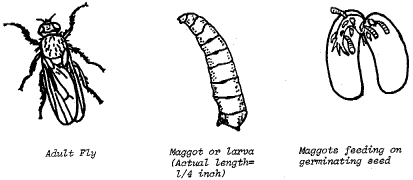
INJURY:
In 1856 the seed corn maggot was first found in the USA in New York State. Since then, it has spread throughout the United States and Southern Canada and it is now believed to be a complex of species of maggots. The seed maggots attack a wide variety of plants including beans, beets, cabbages, turnips, radishes, corn, peas and seed potatoes. Attack is most severe when moist, cool spring conditions contribute to delayed, slow germination and emergence of seeds and young plants. Snap beans are particularly susceptible to seed maggot damage. The cotyledon damage and ìtatteringî of small leaves reduce yield and cause uneven maturity.
DESCRIPTION AND LIFE HISTORY:
The seed maggots spend the winter as puparium in the soil. In early
spring, about planting time, the first generation of adult flies
emerge. The flies are greenish or brownish-gray in color and are
about 1/5 inch long. The eggs are laid just below the soil surface in
recently plowed ground high in decayed vegetable matter. Fresh manure
also seems to attract the flies which feed on the organic matter. The
maggots hatch from the eggs and make their way to the sprouting seeds
where they feed on, and often destroy, the cotyledons and growing
point of the seed or young plant. When full grown the maggots are a
yellowish-white color, tough skinned, legless and about º inch
in length. They change to the pupal stage inside the brown puparium,
a relatively hard shelled brown case. The entire life cycle can be
completed in three weeks. There are at lease three generations per
season in New York State, the first usually being the most
destructive. The second generation occurs in late June to early July,
and another in August and September.
The seed maggot population is erratic, appearing in large damaging
numbers in a field one year, but maybe only a few appearing the
following year. Infestations in unprotected cultivated crops are not
usually found until considerable seed and plant damage has occurred
and it is too late for effective control.
Back to Pest Information
|
|
Shrews, meadow mice and moles are common, native, small animals frequently encountered around the home landscape. Sometimes considerable confusion arises concerning the identification of these animals and the significance of their presence to the homeowner.
 |
SHREWS: Shrews have pointed noses, small eyes and ears which are almost completely hidden in their soft, velvety fur. They resemble their close relatives, the moles, in some respects but lack the large, modified feet for digging. The short-tailed shrew, Blarina brevcauda and the common shrew, Sorex cinereus are two species commonly observed in New York. The short-tailed shrew is approximately 5 inches long, dark, slate colored above, pale below, with a short, dark black 1 inch tail. The common shrew is slightly smaller with a maximum length of 4 inches, brown above speckled with lighter or darker hairs, grayish to buff beneath with a yellowish brown slender tail. |
Shrews are very active creatures sometimes seen even in daylight in their constant search for prey. Insects and insect larvae, slugs, worms and larger animals such as mice make up the bulk of their diet. Vegetable and plant materials make up a very small portion of their diet and are eaten only when other food sources are unavailable. They must eat approximately 3 times their own weight in food each day to stay alive which makes them useful as beneficial destroyers of insects and other pests.
Shrews are commonly found in and around gardens, fields, and wooded areas, but occasionally they may find their way into the home. Once inside they may become a nuisance but do not cause damage. In cases where their presence becomes intolerable, they may be trapped using a snap back mouse trap or small live trap baited with liver or other meat. The traps should be placed flush against the wall where shrews commonly run.
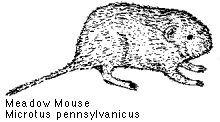 |
MEADOW MICE: Meadow mice, Microtus pennsylvanicus, are found throughout New York State wherever there is grass which makes up the bulk of their diet. Adult mice are chestnut brown above, gray beneath sprinkled with cinnamon. Full grown mice measure up to 7 inches in length including a tail of less than 2 inches. These mice are blunt-nosed, short-eared, blocky in form, with small eyes and short legs. |
Meadow mice are active all year. They construct an intricate network of shallow surface runways through vegetation and surface litter. Grass cuttings and small piles of droppings litter well-used runways. Globular, compact nests of interwoven grass are built under snow, under old boards, in a tuft of grass or underground at the end of a shallow burrow. Meadow mice are active both day and night with peak periods of activity in early morning and late afternoon.
The potential breeding rate of meadow mice is very high. Each female may produce up to 10 litters of 3 to 8 young in a single growing season and occasionally more litters are born during the winter. Young are ready to breed when 2 months old. This tremendous reproductive capacity may make this small rodent a serious pest in instances when its population is not kept in check.
Meadow mice eat almost any kind of plant material. Grasses and herbs make up the bulk of their food during most of the year but, during fall and winter, the cambium layer of bark is also eaten. Meadow mice occasionally burrow in loose or very light soils feeding on roots and tubers.
Local populations of meadow mice vary greatly from year to year and in years with high populations they can become very destructive around the home. Usually the first signs of meadow mouse activity are noticed in the spring. Just as the snow melts, the homeowner finds areas of his lawn displaying a ragged, chewed-up appearance where meadow mice have been living under the snow during the winter. Numerous, shallow runways are visible on the lawn surface, often with one or more interwoven grass nests and occasionally several small burrows. Piles of mouse droppings may be seen at the junctions of these runways and sections of clipped grass may be found along the runways indicating mouse activity. Ordinarily, no permanent damage has been done to the lawn and the mice usually retreat from the open lawn to more protected areas with the vanishing snow cover.
This mouse activity is frequently blamed on moles but can be readily distinguished from the work of moles because moles do not construct surface runways through the grass, but dig a network of tunnels beneath the soil surface. Moles force up ridges or push up mounds of soil to the surface. Grass is not eaten nor are grass nests found on the lawn surface, if moles are responsible.
During the winter meadow mice sometimes injure trees and shrubs by eating away the bark at the base of trees and shrubs exposing the light colored wood beneath. Occasionally this type of injury may be found as high as the winter snow, sometimes several feet off the ground. Frequently this type of injury results in complete girdling of affected plants and causes their subsequent loss later in the growing season. If caught early, girdling injury can be repaired by bridge grafting but plant growth is always seriously set back.
In late spring and summer, meadow mice can damage growing plants and ripening vegetables. They eat into the exposed portions of beets, low lying tomatoes and other vegetables. In some cases they may burrow down to feed on buried crops such as potatoes.
Field mice can be easily controlled in small areas, such as lawn or gardens, by ordinary snap back mouse traps but, to be effective, a dozen or more traps should be used. Locate the mouse runways in grassy borders of the lawn or garden and set the traps in or at right angles to the runways, flush with the runway floor. Traps may also be set at 10 foot intervals along the plant rows. Use a pinch of oatmeal or peanut butter sprinkled over the trigger of the trap as bait. Avoid using bait such as bacon which may be attractive to birds or pets. Mice often invade lawns or gardens from adjacent weedy or grassy areas which should also be thoroughly trapped. Traps should be reset daily and freshly baited until no more mice are caught. It may be necessary to repeat this procedure several times during the growing season as more mice move in from outside areas.
Mowing of grassy or weedy borders and of unkempt grassy-weedy areas will help reduce the meadow mouse population. Removing high grass and weeds from around desirable ornamentals and fruit trees is also helpful. Certain herbicides may also be used cautiously along fence rows, around plants and on waste areas to reduce weed and grass cover.
Mouse injury to trees and shrubs can be prevented by using wire guards encircling the tree or shrub at the base, with the lower end of the wire embedded firmly in the soil. Galvanized hardware cloth with º inch mesh and 19 to 24 inches wide is commonly used to form a cylinder large enough to allow for growth over a period of several years.
MOLES:
Moles belong to the insect-eating group of mammals and are
highly specialized for their life beneath the soil. They are
sometimes confused with the field mice or shrews but can be easily
identified by their greatly enlarged forefeet modified for digging.
Adults are from 5 to 8 inches long and have very small concealed eyes
and ears with short, thick, dark, soft, velvety gray fur that is
smooth if brushed either way. The two species commonly encountered in
New York State are the common mole, Scalopus aquaticus and the
star-nosed mole, Condylura cristata. The star-nosed mole has 22 pink
finger-like projections around its nose which readily identifies it
from the common mole whose nose is more pointed like a pick.
Moles seldom venture above ground and spend most of their lives within their extensive systems of underground tunnels, where a circular nest chamber is excavated and lined with leaves and grass. A single litter averaging four young is produced in late April or early May. Young moles leave the nest in four to five weeks.
Insects, insect larvae (especially white grubs) and earthworms make up the bulk of the moleís diet but they also occasionally feed on plant material such as bulbs. Moles more commonly damage lawns, gardens and golf greens with their tunneling activities in search of insects and worms. Soil is forced up in sinuous ridges by common moles. Star-nosed moles usually work deeper in the soil and build up mounds of soil on the surface.
Moles are difficult to control because of their subterranean habits. They can be controlled most successfully through the use of special mole traps designed to overcome the difficulties of trapping them within their tunnels. These traps, of which there are several types, may be purchased from hardware dealers and garden supply stores.
Before setting mole traps it is necessary to locate tunnels that are in current use. The common mole digs a network of deep tunnels as well as a network of surface burrows and, while the deep tunnels are in more or less permanent use, some of the surface tunnels are only temporary structures dug by the mole in search of food and perhaps used only once. Surface tunnels of the common mole may be easily identified by the ridge of soil above them. Active surface tunnels may be located by pushing down the surface ridges on a number of tunnels and noting which ones are repaired within a day or two. Deeper tunnels can be located by pushing a pointed rod or stick into the ground and noting the change in resistance when the rod breaks into a tunnel. These are the places to set mole traps.
The star-nosed mole does not leave a soil ridge above its underground runs as does the common mole. Where the star-nosed moles tunnel to the surface, they leave a mound of soil. It is necessary to dig around these mounds a little to locate a tunnel before the trap can be set in place. The trap should be set in a straight section of tunnel and the harpoon worked up and down several times to be certain that nothing is in the soil to impede its function.
Snap back mouse traps may also be used to catch moles. The traps are placed with the trigger at right angles to the tunnel after excavating down to the tunnel floor. It is not necessary to bait the trap as the mole should be caught when attempting to clear the trap from the tunnel. After setting, the hole should be covered with something such as a board or box to exclude light.
Grassy areas such as lawns and golf greens may be treated with
insecticides to reduce insects and other mole food sources. When food
is no longer plentiful, the moles will go elsewhere.
Back to Pest Information
|
|

INJURY:
The silverfish (Lepisma saccharina) and the firebrat (Thermobia domestica) cause damage in homes by eating foods and other materials that are high in protein, sugar or starch. They feed on cereals, moist flour, any paper on which there is glue or paste, sizing in paper including wall paper and book bindings, starch in clothing and rayon fabrics.
DESCRIPTION:
Both silverfish and firebrats are slender-bodied, about 1/2 inch in
length and wingless. Their bodies are covered with scales, shiny
silver or pearl gray for silverfish, and mottled gray for firebrats.
The immature insects look like the adults but are smaller in size.
Both have two long antennae at the head end and three long tail-like
appendages at the hind end. The appendages are almost as long as the
body.
Silverfish and firebrats are common in houses throughout the United States. Silverfish live and develop in damp, cool places, especially basements. Large numbers can sometimes be found in new buildings in which the walls are still damp. The firebrat lives and develops in hot, dark places such as around furnaces, fireplaces and in insulation around hot water or heat pipes. Both are active at night and hide during the day. In apartment houses these insects follow pipelines from the basement to the rooms on lower floors where they find food, They may be found in book cases, around closet shelves, behind baseboards, and behind window and door frames.
LIFE HISTORY:
Silverfish and firebrats develop slowly under usual household
conditions and produce few young. They are able to live without food
for several months. The females lay eggs at any season in secluded
places such as behind books or on closet shelves. Silverfish lay eggs
singly or only a few at a time, but may deposit several batches over
a period of weeks. Firebrats deposit about 50 eggs at one time, and
again, may lay several batches. Eggs hatch in 2 weeks or longer and
the rate of growth of the young depends on the temperature and
humidity in the building. Silverfish and firebrats may reach maturity
in 3 to 24 months.
Back to Pest Information
|
|
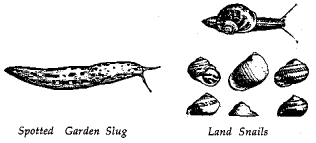
INJURY:
Slugs and snails are often present in greenhouses throughout the year and in home vegetable gardens, flower and ornamental borders during most of the summer. Injury to plants consists of chewed holes in leaves, stems, flowers and fruit. Seedlings may be totally destroyed.
DESCRIPTION:
Slugs and snails are mollusks, a group of invertebrate animals with
soft unsegmented bodies. Slugs are often described as snails without
a shell, while snails are enclosed in calcareous shells. Slugs and
snails move along by secreting a path of mucus.
LIFE HISTORY:
Many species overwinter in the egg stage, but eggs may also be found
at other times of the year. The eggs resemble little round spheres,
are whitish to clear in color, and are often found in masses just
below the soil surface. The young slugs resemble the adults and begin
feeding as soon as they hatch. The life span for most species is
usually less than one year.
Immature and adult slugs and snails that overwinter become active in the early spring when temperatures are consistently above 40 degrees F (5 degrees C). A wet spring and early summer usually result in a buildup of slug populations. Dry weather is often detrimental to slugs, and they may either die or burrow deeper into the soil to await moist conditions. Cool damp fall weather is conducive to much slug injury.
Slugs and snails are active mostly at night, and the slime trail
they leave is an indication of their presence. Early in the morning
this trail may appear as silver streaks on the plant surface, but as
the day progresses it dries out and becomes less visible. (In
contrast, caterpillars which cause similar feeding injury do not
leave a slime trail.)
Back to Pest Information
|
|
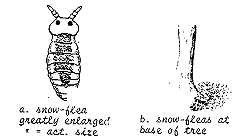 |
The insect nicknamed the "snow-flea" is not a flea at all, but instead is a species of springtail that may occur in very large numbers on the snow. In some instances they may be so numerous as to color the snow black. In British Columbia there is a minute yellow springtail that is said to cover the snow with a "carpet of gold". |
The snow-flea Achorutes nivicola Fitch was written about as early as 1847 by Asa Fitch. He wrote of it:
"This is an abundant species in our forests in the winter and fore part of spring. At any time in the winter, whenever a few days of mild weather occur, the surface of the snow, often, over whole acres of woodland, may be found sprinkled more or less thickly with these minute fleas, looking at first sight, as though gunpowder had been there scattered. Hollows and holes in the snow, out of which the insects are unable to throw themselves readily, are often black with multitudes which here become imprisoned. The fine meal-like powder with which their bodies are coated, enables them to float buoyantly upon the surface of water, without becoming wet. When the snow is melting so as to produce small rivulets coursing along the tracks of the lumbermanís sleigh, these snow-fleas are often observed, floating passively in its current, in such numbers as to form continuous strings; whilst the eddies and still pools gather them in such myriads as to wholly hide the element beneath them."
Later he included an additional note:
"In the early spring the buckets and troughs of the manufacturer of maple sugar are often thronged with these insects."
Although springtails are very common insects and often very abundant, they are seldom observed. Their small size and the fact that they are often found in concealed situations keeps them out of view for most of us. Springtails occur in leaf mold, damp soil, under bark, in decaying logs and in fungi. A few are found on water. Most species are believed to feed on organic debris.
The "snow-fleas" need not be of concern to homeowners as they do
not cause any damage. Their abundance and habit of crawling or
ìjumpingî all over the place attracts attention,
especially when they are contrasted against the white background of
the snow. This is one of the few insects that occur in the adult
stage during the wintertime. It is a curiosity more than anything
else and is of interest to the naturalist as well as the
scientist.
Back to Pest Information
|
|
DESCRIPTION:
Sooty mold is a charcoal black fungus that appears as a black coating on the surface of leaves, fruits, twigs and branches of many deciduous and evergreen shrubs and trees. This fungus is not pathogenic to plants but obtains its nourishment from insect honeydew. Honeydew is a sweet, clear, sticky substance secreted by insects such as aphids, mealybugs, scales and whiteflies. The honeydew drops from the insects to the leaves and twigs. Wind blown sooty mold spores (seeds) that stick to the honeydew then have a suitable medium for growth. When spores germinate, they send out black fungus strands (mycelia threads) that bring about the discoloration. A heavy coat of black mold may build up on twigs over more than one growing season.
INJURY:
On leaves, this coat of mold screens out light and reduces the plants
capacity to produce food. On some trees no obvious damage can be
noticed. Shrubs under trees that are heavily infested with honeydew
producing insects may be seriously damaged or killed because the leaf
chlorophyll cannot function properly. Azalea, Rhododendron, Pieris,
Cotoneaster, holly and other low-growing shrubs, growing under shady
conditions are susceptible to serious damage.
Back to Pest Information
|
|
The spiders are a large, distinct and widespread group of Arachnids occurring in many types of habitats. Many people think all spiders are very poisonous, however, although all spiders have venom glands, they very seldom bite man. Most spiders are beneficial because they feed on insects.
DESCRIPTION:
A spider's body is divided into two sections, the cephalothorax bears
the eyes, mouth parts, and legs; and the abdomen which bears the
genital structures, spiracles and anus. Unlike insects, spiders have
eight legs and no antennae. Some of the most commonly encountered
spiders are:
 |
Jumping spiders - small to medium in size with short legs and stout bodies. The body is hairy and may be brightly colored or iridescent. They are found primarily under stones and in debris. |
 |
Crab spiders - as their name suggests, these medium sized spiders are crab-like in appearance and walk sideways or backwards. These spiders spin no webs, but forage for their prey or wait in ambush for it. One species can change color depending upon the color of the flower it is resting on. |
 |
Nursery web and Fishing spiders - these spiders may be quite large, some having a leg spread of three inches. Many of them live near water, walking over the surface and diving beneath it. They feed on aquatic insects and even small fish. These spiders are rovers and the female spins a web only for the young. The female carries the egg sac underneath her until the young spiders are ready to hatch at which time she ties it to a plant and wraps leaves around it. |
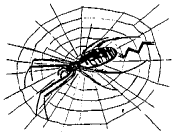 |
Orb weavers - included in this group are the common garden spiders, many of which are brightly colored, black and yellow or black and red. These spiders are usually found resting head downward near the center of their large orb web. |
 |
Harvestman or Daddy-Longlegs - although these animals are not true spiders, but rather a separate order of arachnids, they deserve mention here because they are found in our gardens. These arachnids have a small oval body and extremely long legs. They feed on plant juices and dead insects. |
Ground Spiders and Wolf Spiders - most of these common spiders are also quite large and dark brown in color. They may be found running along the ground chasing their prey. The females carry the egg sac and when the young hatch, they are carried on the female's back for a few days.
TARANTULAS - These spiders are feared because of their size and formidable appearance. The bodies may get up to 3 - 3 1/2 inches in length. Actually they are sluggish spiders and will attack only when they are teased to an extreme. Many are kept for pets. The larger species can inflict a painful wound with their powerful jaws. Tarantulas are desert spiders and are not found in Northeastern States.
BLACK WIDOW - The black widow is timid by nature, however, when accidentally squeezed, will bite in self defense. The venom is highly toxic. The bite causes extreme pain which usually extends to the abdominal muscles. The danger exists because the black widow seeks out dark places in which to construct a retreat, often living in close proximity with man.
BROWN RECLUSE - This spider is known to cause sores that are slow
to heal when it bites. These spiders range from Western Georgia
northward into Kentucky and westward to Kansas and Texas. Since these
spiders are easily transported, it is wise to check vacation gear
when returning from a southern and western vacation. The spiders hide
in dark corners and are generally shy.
Back to Pest Information
|
Pegomya hyoscyami |
 |
INJURY: The spinach leafminer attacks spinach, beet, sugar beet, swiss chard and many weeds including lamb's quarters, chickweed and nightshade. The insectís mines make the vegetables unsightly and unappetizing as well as destroying part of the crop. The maggots feed between the upper and lower leaf surfaces of the host plants mining out the tissue in between. As the maggot grows, the mines coalesce with others and blotches are seen on the affected leaves. It is not unusual for several larvae to be in the same leaf. The spinach leafminer is most injurious to spinach and chard and beet greens. Injury to the leaves of beets, and sugar beets also decreases the size of the root crop. |
DESCRIPTION:
The adult of the spinach leafminer is a fly about º inch long and gray in color. The adults may be seen flying near the ground between the plants. The egg is white and about 1 mm long. The maggot or larval stage is white to yellowish and legless. The puparium or resting stage is a hard, brown structure about 1/5 inch in length.
LIFE HISTORY:
In April or May adult flies of the spinach leafminer appear in the
garden. The females deposit eggs singly or in rows of 2 to 5 side by
side on the underside of the leaves. In 4 to 6 days the tiny maggots
hatch from the eggs and work their way into the leaf tissue. The
larvae excavate the mine, which is at first thread-like, but as the
maggot grows, the mine becomes blotch-like. The larvae are full grown
in 7 to 16 days at which time they drop to the ground and burrow a
few inches into the soil. Here each larva changes to the puparium or
resting stage. Two weeks to a month later the adult files emerge and
will soon lay eggs for another brood. In central New York there are
three generations and a partial fourth each year. Winter is passed as
a puparium in the soil.
Back to Pest Information
|
|

Springtails, scientifically known as Collembola, are minute insects (usually less than 2 mm) that are very common and abundant with nearly universal distribution in moist soil. Because of their small size and somewhat concealed habitats, they are seldom seen. The name springtail refers to the fact that these tiny insects have a forked appendage attached to the back of the underside of the abdomen that can be moved quickly away from the body usually causing the insect to jump. The springtails are often whitish or grayish in color and blend in with their surroundings.
PROBLEM:
Springtails are considered pests in the sense that they are
occasional invaders and may occur in very large numbers. These
insects are commonly found out of doors, but occasionally get into
the indoor environment. Outside they may be seen on the paving blocks
surrounding patios and swimming pools. In buildings springtails are
found in damp places such as kitchens, basements, bathrooms, around
drains, on the floor near patio doors, on wet walls, or in the soil
of potted plants. The majority of species feed on algae, fungi and
decayed vegetable matter, although a few species will feed on living
plants and dead animal matter. Some species also feed on nematodes
and may contribute to the natural control of these tiny worms.
Back to Pest Information
|
|
Part I: Aerial Nesting Wasps and Bees
Note: For ease of use this section is divided into two parts (Part
I: Aerial Nesting Wasps
and Bees and Part II:
Subterranean, Tree and Wall Nesting Wasps and Bees)
Introduction:
Most stinging insects are beneficial to man. Bees make our
honey and are essential for the pollination of many crops. Wasps prey
on large quantities of harmful caterpillars and flies which they feed
to their young. Unfortunately these insects often build their nests
near occupied dwellings and many become a nuisance or even a danger
if a person is allergic to their sting.
Most bees and wasps that are a stinging problem are social insects. This means that they generally occur in large numbers in the same nest. Because they occur in large numbers, the only effective method of control is to locate and destroy their nests. The remainder of this bulletin covers the identification, location and destruction of such nests.
Types of Aerial Stinging Insects and Their
Nests:
Polistes or paper wasps are reddish-brown to
dark brown, long-legged insects with spindle shaped abdomens. These
wasps construct circular, gray paper nests which resemble a honey
comb from the underside and seldom exceed four inches in diameter.
The nests are frequently found under the eaves of houses, in little
used buildings and in attics. The nests are annual (used for only one
year).
Hornets are large black insects with white or yellow markings. They are built more stockily than Polistes or mud daubers. Their nests resemble a large gray, coarsely textured football or giant egg and are constructed of a papiermache- like material. The nests are less common than Polistes nests and may be found under eaves and hidden in shrubbery or on tree branches. An active nest may contain over 200 adults. The nests are seasonal.
Mud daubers have extremely long, thin waists and are blue to metallic black in color. Their nests are a series of mud cells which often resemble finger-like projections. The adult female provisions the nest with paralyzed spiders for the young to eat. They are not social wasps and the female leaves the nest after she provisions it. The adults are much less likely to sting than the social wasps.
Honey bees are relatively small, hairy, yellowish brown insects, though dark brown or black honey bees are not uncommon. They are normally kept in bee hives but they will nest in trees and between the walls of houses. The removal or destruction of such nests is covered in Part II of this bulletin. Quite often during the months of May and June and less frequently throughout the summer, "swarms" of honey bees may be encountered on the sides of buildings or on nearby trees. These swarms are composed of honey bees which have left the old hive to start a new one and they may include as many as 4,000 to 30,000 bees. The swarms are generally quite gentle if unmolested and will remain for a day or two before flying to their new home site.
Yellow jackets,
bumble bees, the giant tree-nesting
hornets and permanently nesting honey bees are
covered in Part II of this bulletin.
Back to Pest Information
|
|
Part II: Subterranean, Tree and Wall Nesting Wasps and Bees
Introduction:
Most wasps and bees may be divided into two groups depending
on their nesting habits. Those species which live in exposed paper or
mud nests have been dealt with in Part I of this bulletin. Part II is
concerned with those wasps and bees which nest underground, in hollow
trees, or sometimes utilize man-made cavities (walls, foundations,
attics, etc.). These insects live together and cooperate in many
ways. For this reason they are collectively referred to as social
insects. Such groups, although beneficial, often have well developed
defense systems; that is, they sting when disturbed. Thus, effective
identification and extermination sometimes become necessary.
Subterranean (Ground) Nesting Wasps and
Bees:
Bumble bees are large, "furry",
yellow and black insects (sometimes tinged with orange) often seen
visiting flowers. These bees are not particularly aggressive but will
sting if their nest or nest entrance is disturbed. Their small nests
are often built in abandoned mouse holes, and for this reason they
are most commonly encountered in field situations, but may also be
found in mattress or insulating materials. Bumble bee nests are
annual and only reproductive females or queens overwinter.
Yellow jackets, commonly mistaken for bees, are actually shiny yellow and black wasps. In New York State these small insects are annual nesters. Every spring reproductive females start nests in small ground depressions and cavities. The only evidence of such a nest is a small ground-level entrance. Yellow jacket nests are usually not discovered until their populations are near their peak in late July or August; disturbing a nest at this stage can be quite unpleasant and even dangerous. It should be noted that these wasps will often adopt cavities within the foundations or walls of houses. Foragers from late-season yellow jacket nests can number in the thousands and sometimes become a nuisance in backyards and picnic areas. Yellow jackets capture flies and other insects to feed their young, and also seek out flower nectar and other sweet liquids. Generally insect foragers are less aggressive than those individuals at the nest site.
Honey bees, our most numerous pollinators, are relatively small hairy insects. They vary in color from the usual golden-brown to darker browns and even black. Honey bees cause concern under two circumstances. (1) The box-like hives used by hobby and commercial beekeepers often become too crowded for a given colony of bees, and a group of bees (a swarm) will leave to start a new colony. Frequently such swarms settle temporarily on the side of a house or tree. (2) Oftentimes, however, a group of bees will start a new hive in a hollow tree or within the walls of a house. These permanent home sites cause the greatest problem. Honey bees tend to defend their new home against any inexperienced intruder. Honey bee nests are perennial. These insects survive the winter by huddling together forming a tight warm cluster.
The European hornet is a large heavy
bodied wasp. It is brown in color with yellow and orange markings.
This species was introduced into North America in the mid-1800's. Its
biology is quite similar to that of the yellow jacket, but it prefers
hollow trees as a nesting site. It will also accept man-made cavities
especially the outside walls of houses. The nests of this species are
annual and only a small number of queens overwinter. The European
hornet is unusual in that it often flies at dusk and even in the
early evening. For this reason it sometimes becomes a pest near
outdoor lights and on window screens.
Back to Pest Information
|
Melitta cucurbitae (Harris) |
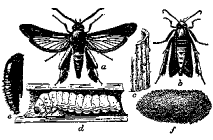 |
DESCRIPTION: a = male moth, b = female with wings folded at rest, c = eggs shown on a bit of stem, d = full-grown larva in vine, e= pupal cell. All 1/3 larger than natural size. |
INJURY:
The larvae bore into the stems of squashes, pumpkins, gourds,
cucumbers and muskmelons. Infested vines at first exhibit wilting,
and later may be completely girdled and rot beyond the point of
attack.
An infestation may be detected by the presence of coarse, yellowish grains of frass (fecal matter) that collect on the ground under the vines. Later the frass becomes moist and shiny, and may be seen oozing from holes in the stems.
LIFE HISTORY:
Adult moths emerge from the pupae about the time vine crops come up.
In New York State this is usually during the latter part of June. The
moths are active daytime flyers and are often mistaken for wasps.
Eggs are laid singly and glued to stems and leaf stalks near the base
of the plant. The young borers enter the plant about two weeks later
and begin feeding on the inner tissues. The larvae feed for about one
month. If an infected vine is split open, it will be hollowed out and
partially filled with frass. Late in the season borers may be found
throughout the plant stem and in the fruits. When fully mature, the
larvae leave the stems and make cocoons in the soil. The larvae
usually over winter in the cocoons, changing to pupae the following
spring.
In warmer climates there may be two generations per year. The
first generation, however, causes the most damage because it attacks
the young squash plants.
Back to Pest Information
|
Acalymma vittata (Fabricius) |
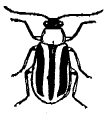 Striped Cucumber Beetle Adult ( x 5) |
INJURY: Striped cucumber beetles are carriers of bacterial wilt, a serious disease of cucurbits. As they feed they transmit the bacteria from one plant to another, and carry it over the winter when they hibernate. The following spring the beetles may infect new plants with the disease. The greatest injury done by this insect is to the young plants soon after they come up in the spring. The adults feed on them and may even kill them. The larvae cause injury by burrowing into the stem, both above and below the ground. They may also feed on the underside of fruit when it lies on the ground. Adult beetles will feed on flowers and destroy them by eating off pistils. New broods of beetles may feed on the rinds of ripening fruits. |
DESCRIPTION:
The adult beetle is small, 1/4 inch in length. The head is black, thorax yellow,
and the wing covers are yellow with three longitudinal black stripes. The mature
larva is 3/10 inch in length, white with a brown head, thorax and anal plates.
LIFE HISTORY:
The adult beetles hibernate under trash or if such protection is not
available, they will burrow into the soil below the frost line. The
adults emerge from April to June usually before the cucurbit plants
are up and feed for a time on pollen from flowers of apple, horse
chestnut, lilac and many others. When squash and cucumbers start to
shoot up the beetles quickly congregate on them.
After feeding for some time, the adults mate and the females begin
to lay eggs. Eggs are laid wherever the female is feeding, often near
the base of the plant. In a week or more the eggs hatch and the
larvae work their way to the cucurbit. Here they burrow into the root
and underground stem tissue and feed for about a month. The mature
larva constructs an earthen cell a few inches below the soil surface
and pupates. The adult beetles emerge in late August or September and
feed on pollen until killing frosts occur.
Back to Pest Information
|
|
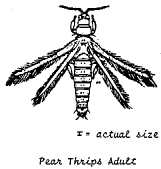 |
Tiny black insects, commonly called thrips, could be responsible for the abnormal appearance (leaf tatter) of sugar maple foliage in many areas across New York State. Recently, foresters in Pennsylvania associated the pear trips (Taeniothrips inconsequens (Uzel) with sugar maple leaf distortion and defoliation. The pear thrips, a native of Europe, was introduced as early as 1904 to California and later was found on the East Coast. The pear thrips is economically important to growers of plums, cherry, apple and pear on the West and East Coasts. Additional hosts of the pear thrips are maple, basswood, birch, beech, ash, and black cherry. In Europe, this insect is associated with woodland vegetation. |
LIFE CYCLE AND DESCRIPTION:
The adult pear thrips has a slender brownish body and is 1.2 - 1.5 mm
long with a yellow to orange subintegumental segment. Its head is
swollen behind the eyes and has red pigmented ocelli. Antennal
segments V and VI are broadly jointed, the third segment is yellowish
brown. Tarsi are yellowish-brown and the fore tarsi have an apical
tooth adapted for digging. Wings are long, narrow, and fringed with
long hairs. The fore wings are brown and the hind wings are pale.
Only female pear thrips are known to occur in North America. Therefore, the thrips probably reproduce asexually (parthenogenesis). Both sexes are found in Europe. Eggs are laid mainly in the petioles of blossoms and leaves as soon as buds open. Egg laying is performed with a sharply pointed down-curving, saw-toothed ovipositor. Small brown scars develop soon after eggs are laid.
Young pear thrips are small and white with red eyes. Because the larvae feed on the foliage, they may add to the injury caused by adults. After two or three weeks of feeding, the larvae fall to the ground, enter the soil to depths of up to 40 cm and form pupal cells. Strong spines on the 9th and 10th abdominal segments are used to penetrate the soil and mold a pupal cell. In the fall, the insects pupate within the cells and remain in the soil until the following spring. Adult pear thrips emerge in spring when soil temperature has risen to between 7 or 12 degrees Celsius (45 to 50 degrees F). After emergence, adults migrate to the expanding buds and begin to feed. There is apparently one generation per year, adults appearing in late April to early May, and larval feeding finished by early June.
INJURY:
Foliar damage is caused when thrips scrape and rasp tender plant
tissue with their sharp, needle-like mouth parts to feed on plant
liquids. Leaves damaged by the pear thrips are dwarfed, mottled
yellow to green-brown, and distorted. This causes the tree to have a
thin crown, and the effect resembles late frost damage. Blister-like
scars develop along the veins and petioles of the foliage. Moderately
damaged foliage can place the trees under some stress and possibly
cause premature leaf drop in early fall. Severely damaged foliage
could result in early spring defoliation followed by refoliation in
June or July.
Back to Pest Information

|
This site is developed and administered by Lake Technology Solutions, Inc. | www.LakeTS.com | (888) 332-8082 |